使用 LOESS 的多重季节趋势分解 (MSTL)¶
此笔记本说明了如何使用 MSTL [1] 将时间序列分解为:趋势成分、多个季节成分和残差成分。MSTL 使用 STL(使用 LOESS 的季节趋势分解)来迭代地从时间序列中提取季节成分。输入 MSTL 的关键参数是
periods- 每个季节成分的周期(例如,对于具有每日和每周季节性的每小时数据,我们将有:periods=(24, 24*7)。windows- 每个季节平滑器相对于每个周期的长度。如果这些长度很大,那么季节成分将显示出较少的时变性。必须是奇数。如果为None,则使用原始论文 [1] 中的实验确定的默认值集。lmbda- 分解之前进行 Box-Cox 变换的 lambda 参数。如果为None,则不进行变换。如果为"auto",则从数据中自动选择一个合适的 lambda 值。iterate- 用于细化季节成分的迭代次数。stl_kwargs- 可以传递给 STL 的所有其他参数(例如,robust、seasonal_deg等)。请参阅 STL 文档.
请注意,此实现与 1 中存在一些关键区别。必须在 MSTL 类之外处理缺失数据。论文中提出的算法处理了不存在季节性的情况。此实现假设至少存在一个季节成分。
首先,我们导入所需的包、准备图形环境并准备数据。
[1]:
import matplotlib.pyplot as plt
import datetime
import pandas as pd
import numpy as np
import seaborn as sns
from pandas.plotting import register_matplotlib_converters
from statsmodels.tsa.seasonal import MSTL
from statsmodels.tsa.seasonal import DecomposeResult
register_matplotlib_converters()
sns.set_style("darkgrid")
[2]:
plt.rc("figure", figsize=(16, 12))
plt.rc("font", size=13)
MSTL 应用于玩具数据集¶
创建具有多个季节性的玩具数据集¶
我们创建一个具有每小时频率的时间序列,该时间序列具有遵循正弦波的每日和每周季节性。我们将在笔记本的后面演示一个更现实的示例。
[3]:
t = np.arange(1, 1000)
daily_seasonality = 5 * np.sin(2 * np.pi * t / 24)
weekly_seasonality = 10 * np.sin(2 * np.pi * t / (24 * 7))
trend = 0.0001 * t**2
y = trend + daily_seasonality + weekly_seasonality + np.random.randn(len(t))
ts = pd.date_range(start="2020-01-01", freq="H", periods=len(t))
df = pd.DataFrame(data=y, index=ts, columns=["y"])
/tmp/ipykernel_5245/288299940.py:6: FutureWarning: 'H' is deprecated and will be removed in a future version, please use 'h' instead.
ts = pd.date_range(start="2020-01-01", freq="H", periods=len(t))
[4]:
df.head()
[4]:
| y | |
|---|---|
| 2020-01-01 00:00:00 | 2.430365 |
| 2020-01-01 01:00:00 | 1.790566 |
| 2020-01-01 02:00:00 | 4.625017 |
| 2020-01-01 03:00:00 | 7.025365 |
| 2020-01-01 04:00:00 | 7.388021 |
让我们绘制时间序列
[5]:
df["y"].plot(figsize=[10, 5])
[5]:
<Axes: >
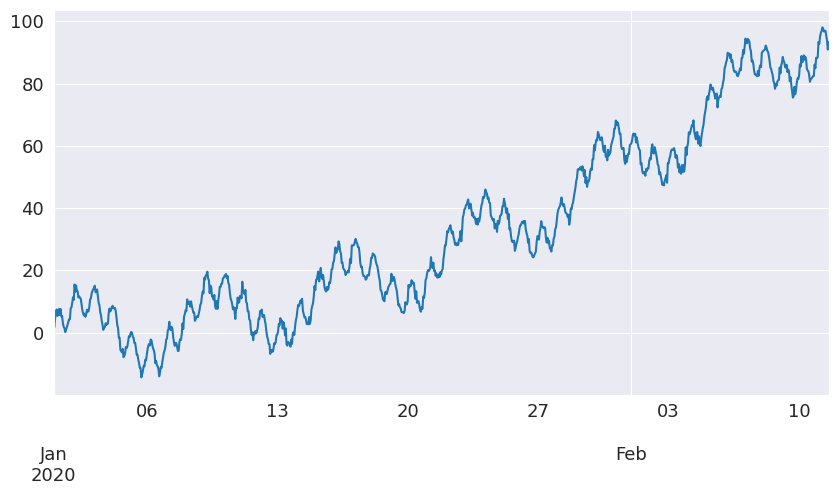
使用 MSTL 分解玩具数据集¶
让我们使用 MSTL 将时间序列分解为趋势成分、每日和每周季节成分以及残差成分。
[6]:
mstl = MSTL(df["y"], periods=[24, 24 * 7])
res = mstl.fit()
如果输入是 pandas 数据框,那么季节成分的输出将是一个数据框。每个成分的周期反映在列名中。
[7]:
res.seasonal.head()
[7]:
| seasonal_24 | seasonal_168 | |
|---|---|---|
| 2020-01-01 00:00:00 | 1.500231 | 1.796102 |
| 2020-01-01 01:00:00 | 2.339523 | 0.227047 |
| 2020-01-01 02:00:00 | 2.736665 | 2.076791 |
| 2020-01-01 03:00:00 | 5.812639 | 1.220039 |
| 2020-01-01 04:00:00 | 4.672422 | 3.259005 |
[8]:
ax = res.plot()
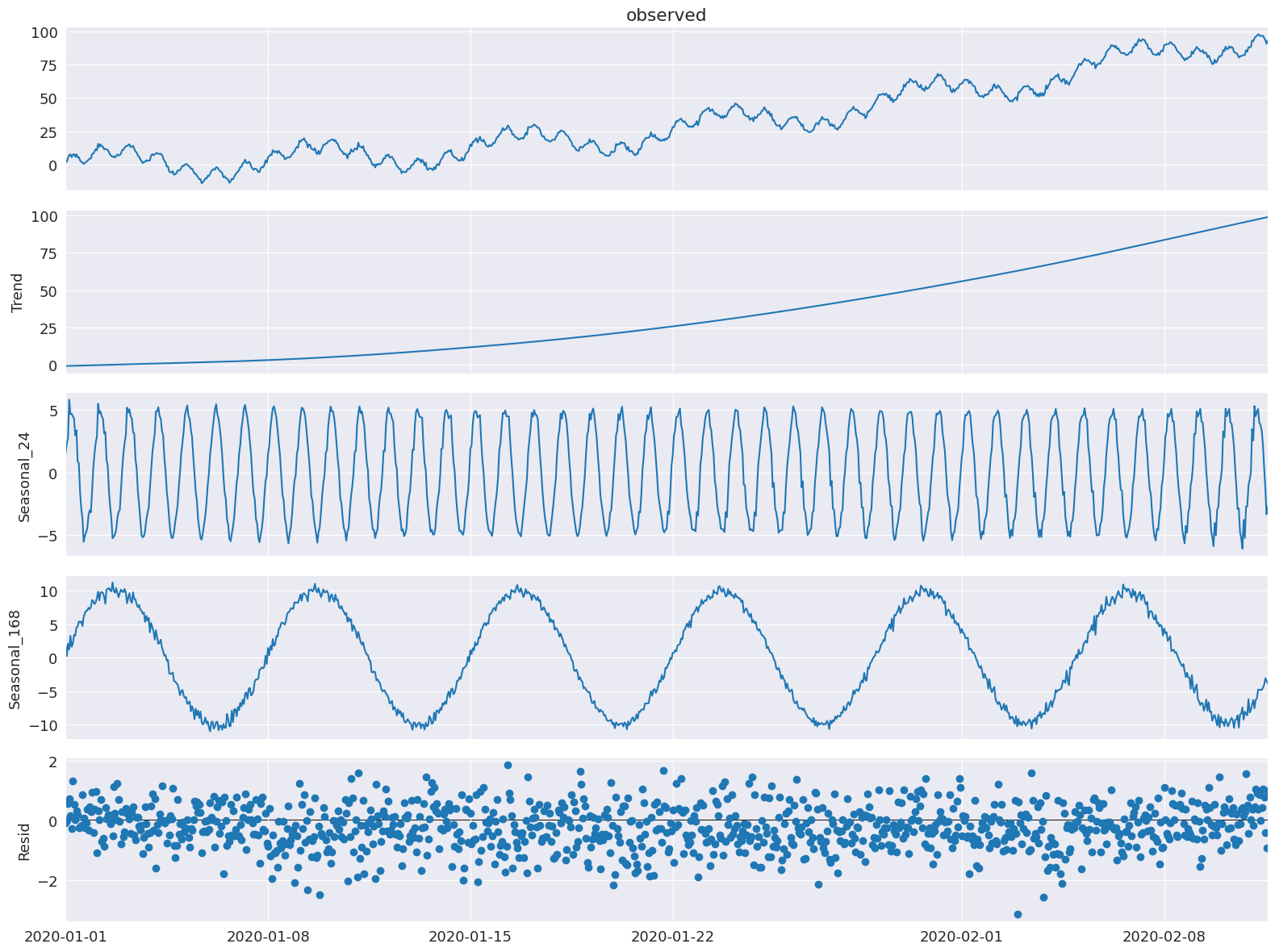
我们看到每小时和每周季节成分已经被提取出来。
除了 period 和 seasonal(因为它们在 MSTL 中由 periods 和 windows 设置)之外,所有其他 STL 参数都可以通过将 arg:value 对作为字典传递给 stl_kwargs 来设置(我们现在将展示一个示例)。
这里我们展示了如何通过 trend 设置 STL 的趋势平滑器,以及通过 seasonal_deg 设置季节拟合的多项式阶数。我们还将显式设置 windows、seasonal_deg 和 iterate 参数。我们将获得更糟糕的拟合,但这只是一个如何将这些参数传递给 MSTL 类的示例。
[9]:
mstl = MSTL(
df,
periods=[24, 24 * 7], # The periods and windows must be the same length and will correspond to one another.
windows=[101, 101], # Setting this large along with `seasonal_deg=0` will force the seasonality to be periodic.
iterate=3,
stl_kwargs={
"trend":1001, # Setting this large will force the trend to be smoother.
"seasonal_deg":0, # Means the seasonal smoother is fit with a moving average.
}
)
res = mstl.fit()
ax = res.plot()
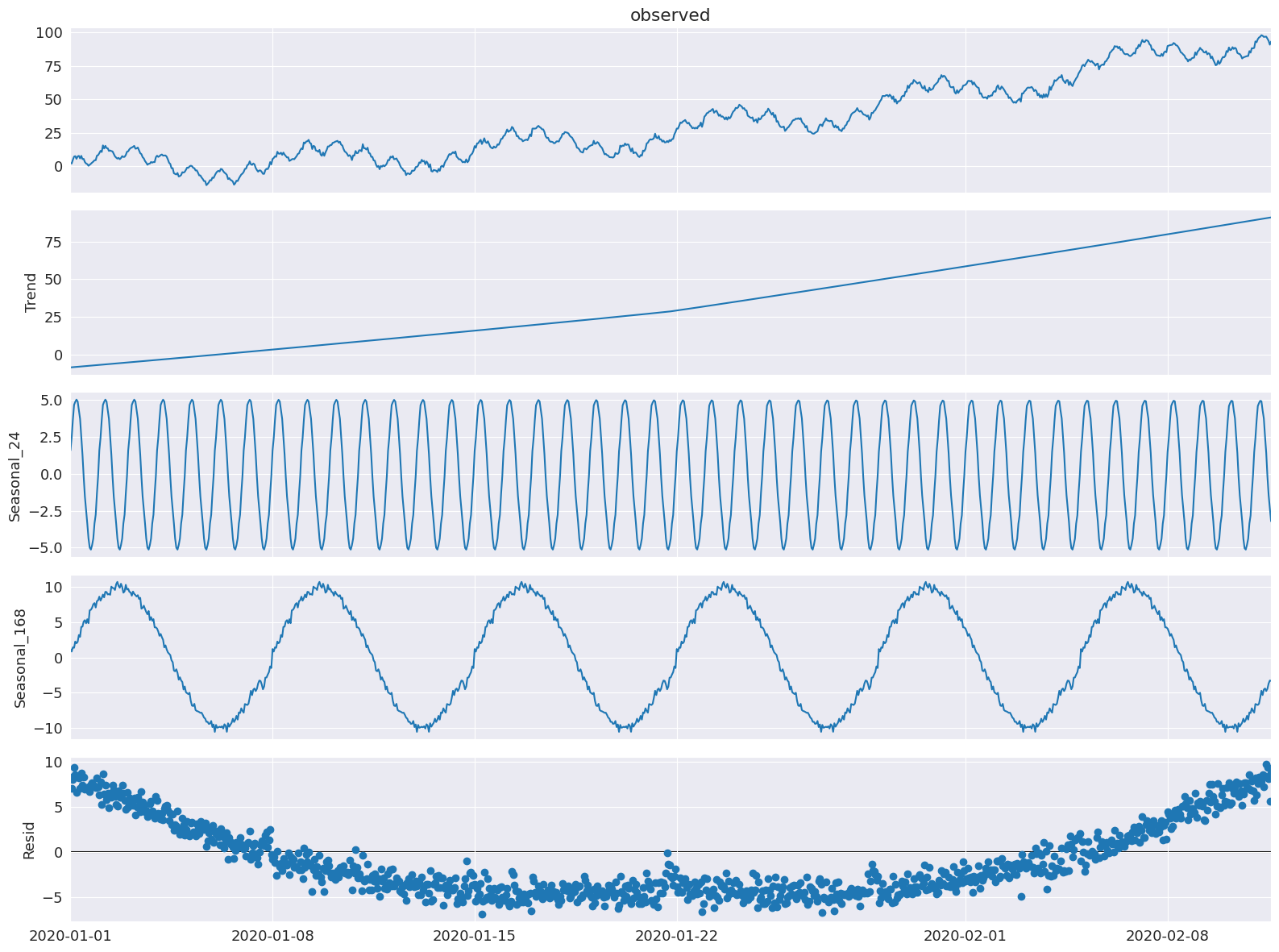
MSTL 应用于电力需求数据集¶
准备数据¶
我们将使用在以下位置找到的维多利亚电力需求数据集:https://github.com/tidyverts/tsibbledata/tree/master/data-raw/vic_elec。此数据集在 原始 MSTL 论文 [1] 中使用。这是澳大利亚维多利亚州从 2002 年到 2015 年初的半小时粒度总电力需求。有关数据集的更详细描述,请参见 此处。
[10]:
url = "https://raw.githubusercontent.com/tidyverts/tsibbledata/master/data-raw/vic_elec/VIC2015/demand.csv"
df = pd.read_csv(url)
[11]:
df.head()
[11]:
| Date | Period | OperationalLessIndustrial | Industrial | |
|---|---|---|---|---|
| 0 | 37257 | 1 | 3535.867064 | 1086.132936 |
| 1 | 37257 | 2 | 3383.499028 | 1088.500972 |
| 2 | 37257 | 3 | 3655.527552 | 1084.472448 |
| 3 | 37257 | 4 | 3510.446636 | 1085.553364 |
| 4 | 37257 | 5 | 3294.697156 | 1081.302844 |
日期是表示从原始日期开始的天数的整数。此数据集的原始日期由 此处 和 此处 确定,为“1899-12-30”。Period 整数表示 24 小时制中的 30 分钟间隔,因此每天有 48 个间隔。
让我们提取日期和日期时间。
[12]:
df["Date"] = df["Date"].apply(lambda x: pd.Timestamp("1899-12-30") + pd.Timedelta(x, unit="days"))
df["ds"] = df["Date"] + pd.to_timedelta((df["Period"]-1)*30, unit="m")
我们将对 OperationalLessIndustrial 感兴趣,它是不包括某些高能耗工业用户的电力需求。我们将对数据进行每小时重采样,并将数据过滤到与 原始 MSTL 论文 [1] 相同的时间段,即 2012 年的前 149 天。
[13]:
timeseries = df[["ds", "OperationalLessIndustrial"]]
timeseries.columns = ["ds", "y"] # Rename to OperationalLessIndustrial to y for simplicity.
# Filter for first 149 days of 2012.
start_date = pd.to_datetime("2012-01-01")
end_date = start_date + pd.Timedelta("149D")
mask = (timeseries["ds"] >= start_date) & (timeseries["ds"] < end_date)
timeseries = timeseries[mask]
# Resample to hourly
timeseries = timeseries.set_index("ds").resample("H").sum()
timeseries.head()
/tmp/ipykernel_5245/185151541.py:11: FutureWarning: 'H' is deprecated and will be removed in a future version, please use 'h' instead.
timeseries = timeseries.set_index("ds").resample("H").sum()
[13]:
| y | |
|---|---|
| ds | |
| 2012-01-01 00:00:00 | 7926.529376 |
| 2012-01-01 01:00:00 | 7901.826990 |
| 2012-01-01 02:00:00 | 7255.721350 |
| 2012-01-01 03:00:00 | 6792.503352 |
| 2012-01-01 04:00:00 | 6635.984460 |
使用 MSTL 分解电力需求¶
让我们将 MSTL 应用于此数据集。
注意:stl_kwargs 设置为提供与 [1] 相似的结果,该结果使用 R,因此底层 STL 参数的默认设置略有不同。在实践中,手动设置 inner_iter 和 outer_iter 非常罕见。
[14]:
mstl = MSTL(timeseries["y"], periods=[24, 24 * 7], iterate=3, stl_kwargs={"seasonal_deg": 0,
"inner_iter": 2,
"outer_iter": 0})
res = mstl.fit() # Use .fit() to perform and return the decomposition
ax = res.plot()
plt.tight_layout()
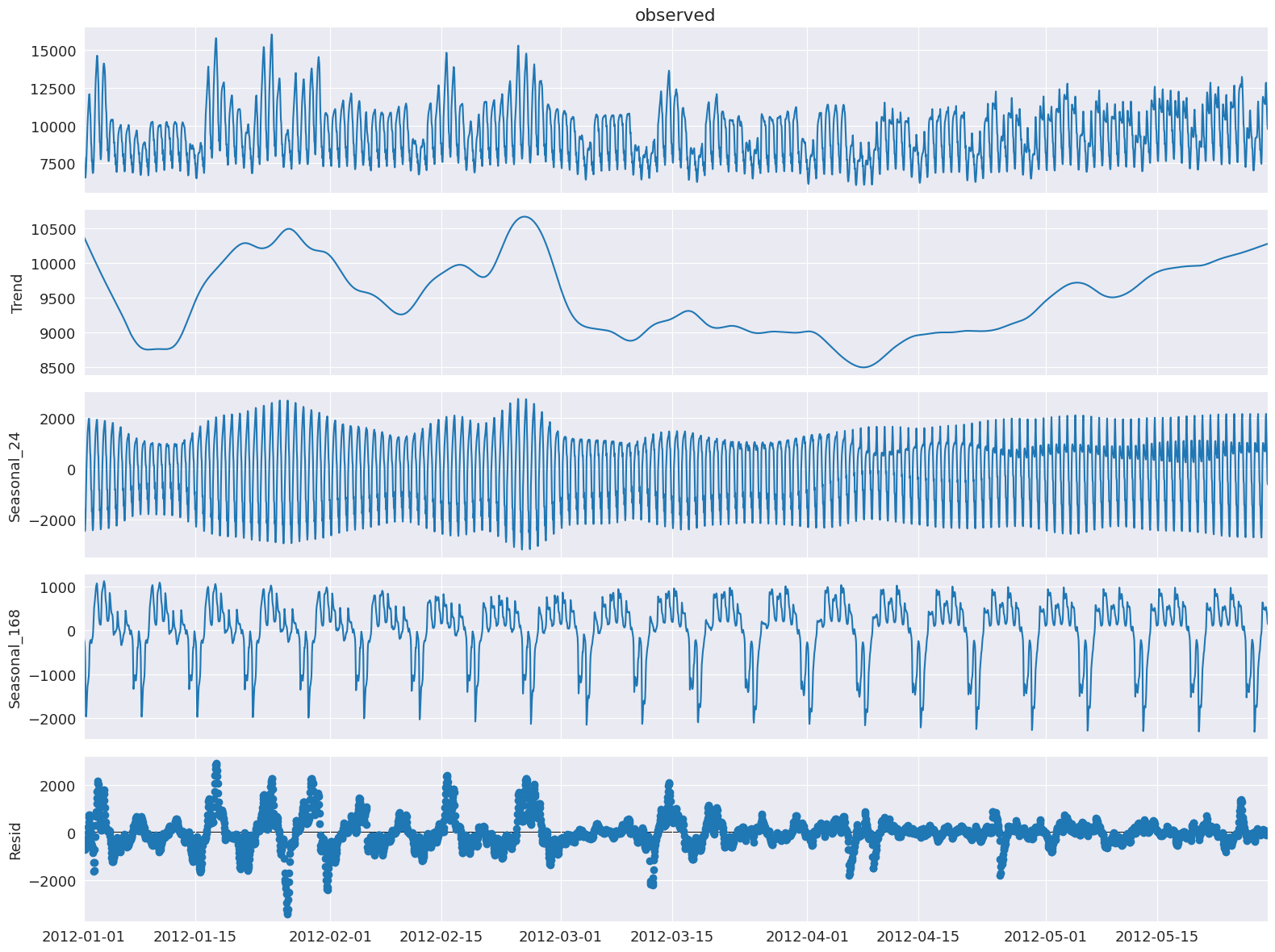
多个季节成分存储在 seasonal 属性中,以 pandas 数据框的形式
[15]:
res.seasonal.head()
[15]:
| seasonal_24 | seasonal_168 | |
|---|---|---|
| ds | ||
| 2012-01-01 00:00:00 | -1685.986297 | -161.807086 |
| 2012-01-01 01:00:00 | -1591.640845 | -229.788887 |
| 2012-01-01 02:00:00 | -2192.989492 | -260.121300 |
| 2012-01-01 03:00:00 | -2442.169359 | -388.484499 |
| 2012-01-01 04:00:00 | -2357.492551 | -660.245476 |
让我们更详细地检查一下季节成分,并查看前几天和几周,以检查每日和每周季节性。
[16]:
fig, ax = plt.subplots(nrows=2, figsize=[10,10])
res.seasonal["seasonal_24"].iloc[:24*3].plot(ax=ax[0])
ax[0].set_ylabel("seasonal_24")
ax[0].set_title("Daily seasonality")
res.seasonal["seasonal_168"].iloc[:24*7*3].plot(ax=ax[1])
ax[1].set_ylabel("seasonal_168")
ax[1].set_title("Weekly seasonality")
plt.tight_layout()
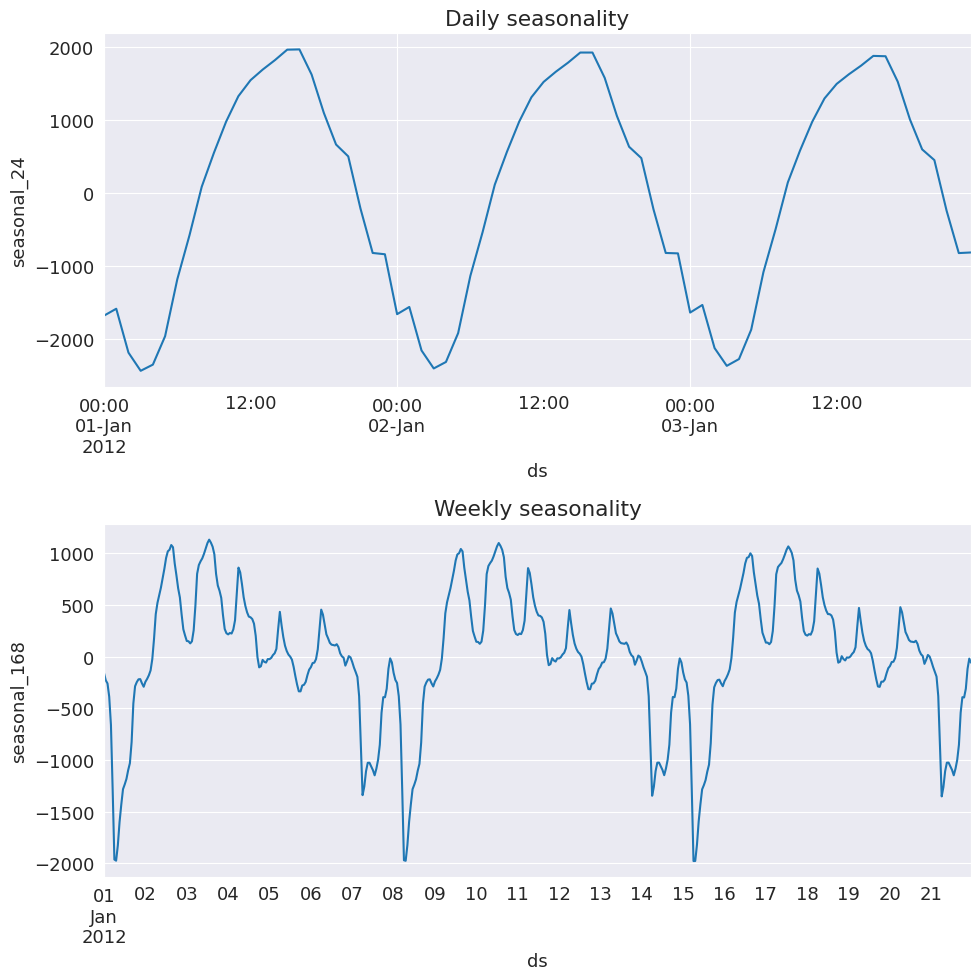
我们可以看到电力需求的每日季节性得到了很好的捕捉。这是 1 月份的头几天,所以是在澳大利亚的夏季,下午通常会有一个峰值,这很可能是由于空调的使用造成的。
对于每周季节性,我们可以看到周末期间的需求量较少。
MSTL 的优点之一是它允许我们捕捉到随着时间推移而变化的季节性。因此,让我们看看 5 月份较冷月份的季节性。
[17]:
fig, ax = plt.subplots(nrows=2, figsize=[10,10])
mask = res.seasonal.index.month==5
res.seasonal[mask]["seasonal_24"].iloc[:24*3].plot(ax=ax[0])
ax[0].set_ylabel("seasonal_24")
ax[0].set_title("Daily seasonality")
res.seasonal[mask]["seasonal_168"].iloc[:24*7*3].plot(ax=ax[1])
ax[1].set_ylabel("seasonal_168")
ax[1].set_title("Weekly seasonality")
plt.tight_layout()
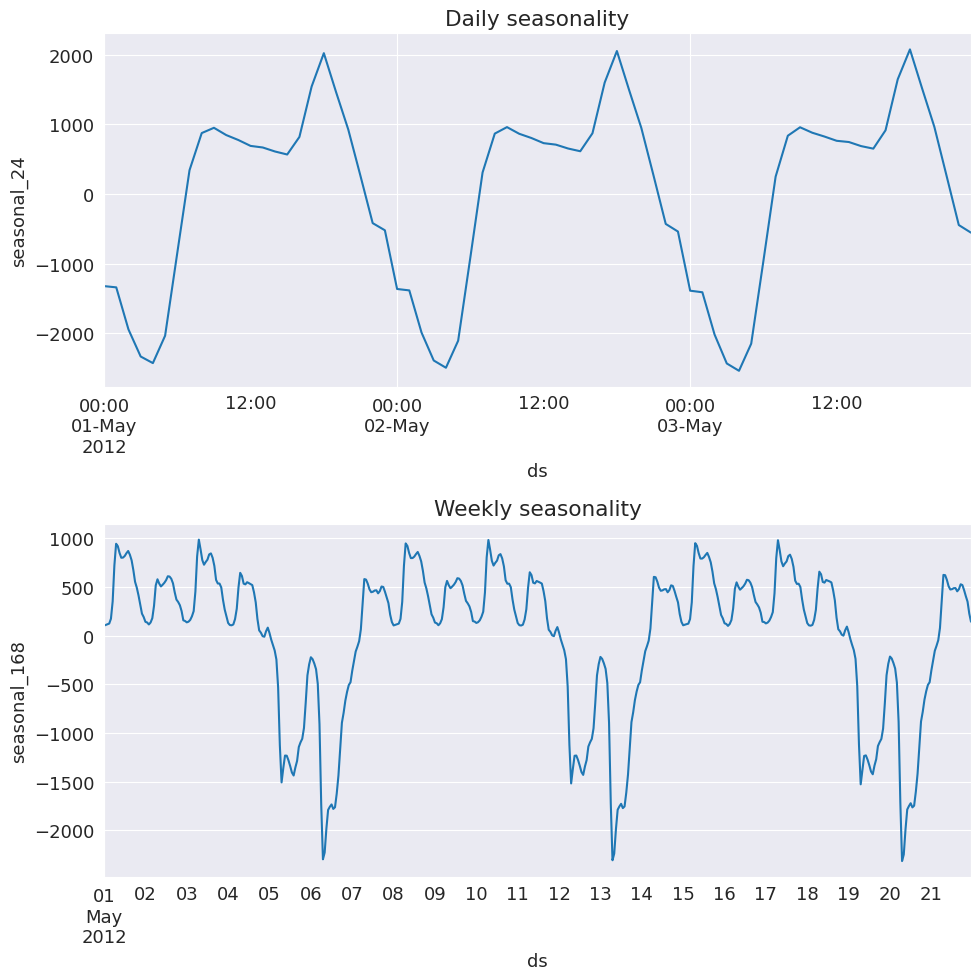
现在我们可以看到晚上还有一个额外的峰值!这可能与晚上现在需要供暖和照明有关。所以这是有道理的。我们看到周末期间需求较低的整体每周模式仍然存在。
其他成分也可以从 trend 和 resid 属性中提取
[18]:
display(res.trend.head()) # trend component
display(res.resid.head()) # residual component
ds
2012-01-01 00:00:00 10373.942662
2012-01-01 01:00:00 10363.488489
2012-01-01 02:00:00 10353.037721
2012-01-01 03:00:00 10342.590527
2012-01-01 04:00:00 10332.147100
Freq: h, Name: trend, dtype: float64
ds
2012-01-01 00:00:00 -599.619903
2012-01-01 01:00:00 -640.231767
2012-01-01 02:00:00 -644.205579
2012-01-01 03:00:00 -719.433316
2012-01-01 04:00:00 -678.424613
Freq: h, Name: resid, dtype: float64
就这样!使用 MSTL,我们可以在多重季节时间序列上执行时间序列分解!